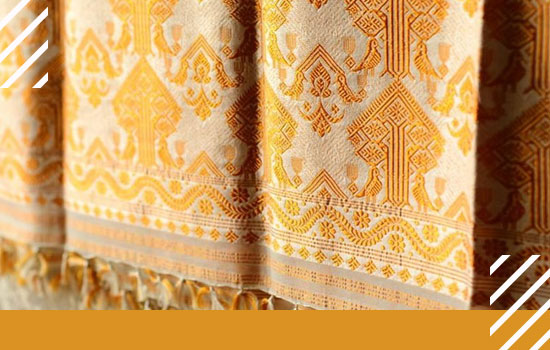India has been home to various art forms that transformed civilizations.
The cultural heritage and legacy of various crafts in India not only display the stories of bygone eras but also the livelihoods that are deep-rooted in Indian culture.
Assam has been one of the greatest contributors to the crafting culture of India.
It is home to some of the biggest surviving handicraft industries in the country.
The Bell Metal Industry of Sarthebari is one of such great art forms. It is home for the second largest handicraft in Assam.
This craft survived ages but yet, didn’t lose its relevance through the course of a thousand years.
Here is all you need to know about Bell Metal and the Artisans of Sarthebari!
Recommended Story – P-TAL: The Art Legacy of Punjabi Thathera
Sarthebari: The Home for Bell Metal
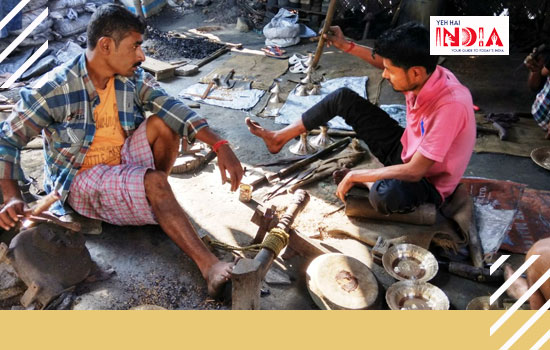
Sarthebari is a town area committee in the eastern part of Assam. It is located about 70km away from Guwahati in Balaji District.
The town is home for bell metal, the second largest handicraft in Assam only after bamboo.
Traditionally, the town is known for its utensils made of bell metal and their assamese structures called the ‘xorai’.
Bell Metal is an alloy of copper and tin.
Utensils are made from these compositions are often used for domestic and religious purposes.
This particular craft is believed to have survived ages but there seems to be little transition in the way the products are prepared.
The craftsmen of the village are referred to as ‘kahar’ or ‘orja’ and still resort to the age-old methods and tools for shaping the metal manually.
History and Significance
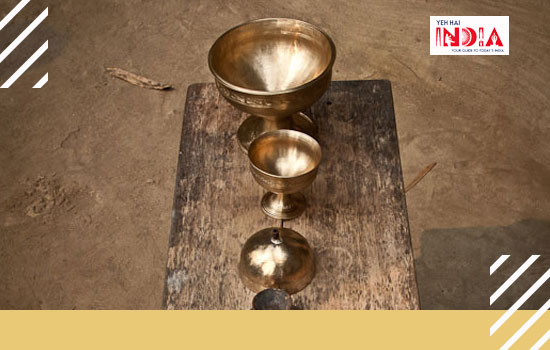
The history of this craft has received significant attention from various scholars. The tradition is believed to have started ages ago dating back to the 7th Century AD.
Various historical texts and records reveal that the bell metal industry had become popular during the times of Kumarbhasakarvarman, the King of the Varman Dynasty.
The Kumar of Eastern India has gifted the traditional bel-metal drinking vessels to Harshavardhana of Kannauj.
Scriptures also state that a pair of Bhortal and Cymbal, the traditional musical instruments, were gifted to Hieuen Tsang, an eminent Chinese scholar.
Other versions of History also state that the Bell Metal has received significance during the period of Ahoms.
Various kings of the dynasty took special measures to depict valor and symbolism through bell metal, especially King Swargadeo Siva Singha.
Ahoms reign marked the golden period for the bell metal.
The use of various bell-metal utensils have been accustomed by everyone including the nobles and the subjects.
Kings of Ahom were complacent in using Maihang Kahi (metal plate) and Maihang bati (metal cup) that are produced under special care by the artisans of Sarthebari.
Products, Importance, and Usage
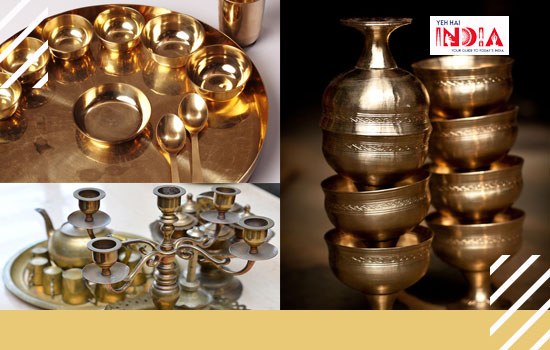
The common products made by the artisans are sarai, a platter or a tray, mounted on a metal base, kahi (dishes), lota and kalah (water pots), and cal (cymbals).
Most of the products are used for religious and domestic purposes.
Conventionally, the utensils made of bell metal are used by Royal families due to their medicinal properties.
Consuming food or drinking water through these utensils keeps intestinal problems at bay.
About 40% of this village engages in cottage industry and are significant contributors to the Assams’s handicraft sector.
One who takes a stroll around the village can hear the sound of metal and hammering at furnaces almost in every street.
Recommended Story – Koftgari; The Art of Royal Weaponry
Process of Making: Techniques Used
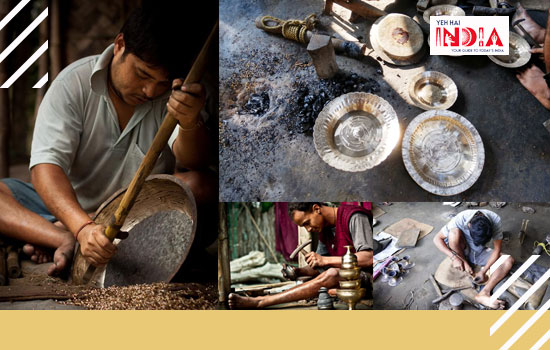
The making of bell-metal products is laborious and tiresome.
This process involves no machinery and all the metal is mounted and shaped through hammering and hand tools.
Main tools include anvils of different sizes locally known as balmuri, chatuli, and akue.
Hammers of various shapes and sizes are used to mount the heated metal.
Pincers flies and chisels are some of the minor equipment used in making of the bell-metal.
Other tools and equipment include Dulari, Gasha, Khatna and Saria. Khatna is an instrument used for polishing the finished products.
Metals and objects like clay, jute, fiber, rice flour, charcoal, borax, zinc and mustard oil are used for making the objects soft and polished.
The craftsmen have inherited their knowledge through heredity and lineage.
Over centuries, the artisans are accustomed to use of these primitive tools to maintain the quality of products.
Despite laborious tasks and bulky weight of metal, each product is made manually to maintain the tradition of quality in bell-metal.
Hence, the products are crafted with both physical strength and artistic skill over centuries.
Challenges Amid Covid-19

Though the tradition of Bell metal survived ages, it has been hit hard by the pandemic.
Two main clusters of Sarthebari are deprived of their conventional workshops, exhibitions, and sales.
The industry has already been plagued with myriad issues like competing factory made replicas, which the customers fail to differentiate with the traditional ones.
Retailers procure these products for a higher margin for sales. The pandemic has only brought more dark clouds to these businesses.
The artisans work 12-16 hours a day to meet their demands in the usual course of business.
During a peak season, an average artisan earns about INR 20,000 to INR 30,000 a month.
Amid the pandemic, most of the workers are now engaged in making of the pre-pandemic orders and are urging the government for special economic packages.
Also Read – Leather Crafts of India





